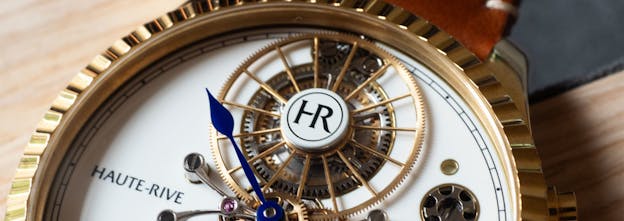Hands On With The 41 Day Haute Rive Honoris I
A thousand hours of power in a surprisingly wearable case.
One of the watches I was most excited to see at Geneva Watch Days was the first piece from a new company called Haute Rive, which was founded by Stéphane von Gunten, formerly of Ulysse Nardin, where he was the company’s research and innovation director. The watch is the Honoris I, and, for the first timepiece this fifth generation watchmaker has produced under his own name, he chose a complication which offers a unique technical challenge – a very long power reserve. The Honoris I has a single, very large mainspring barrel which provides 1000 hours, or 41 days, of running time and at the other end of the going train is a flying tourbillon.

The architecture of the movement is very unusual and while we broke down its structure and function in some detail in our introductory post, it’s worth reviewing again.

The mainspring barrel takes up the entire diameter of the case, and is wound from the knurled bezel (this makes for a more comfortable winding experience than attempting to wind 41 days of running time into the mainspring from a conventional crown). The time can be set from the crown, which is engaged and disengaged from the time setting function – which is its only function – by a switching button at about 2:00 (the column wheel’s visible through an adjacent aperture).

The upper half of the dial is taken up by a complex differential mechanism, which passes torque from the rotation of the bezel on to the ratchet wheel at the center. The differential also powers the “great wheel” superimposed above it, which is the first wheel in the actual going train.
The flying tourbillon is on the same level as the rest of the going train elements visible through the dial. Normally the rest of the going train would be on the same level, but the wheel driving the tourbillon carriage is actually tilted slightly, so that the tourbillon appears to rotate without any directly visible connection to the rest of the train. This allows for a cleaner dial design and also helps keep the Honoris I flatter than usual, overall, for a watch with such a long power reserve – the case is a relatively svelte 42.5mm x 11.95mm, which is actually marginally thinner than a Rolex Submariner (12mm) and much thinner than the A. Lange & Söhne Lange 31, which comes in at 45.9mm wide and 15.6mm thick.

The slimness of the Haute Rive Honoris I is also partly thanks to the use of a flying tourbillon. A standard tourbillon consists of a cage, inside of which is the balance, balance spring, escape wheel, and lever (if the escapement is a lever escapement; you can of course use other escapements in tourbillons, which is why the tourbillon is not, despite the constant use of the expression, an “escapement,” – it is instead, a regulating device). Normally, the cage has an upper and lower pivot which sit in an upper bridge, and lower bearing on the mainplate respectively.
The flying tourbillon, which in its modern form was invented by Albert Helwig, at the watchmaking school in Glashütte in 1920 (although there was in fact a predecessor to Helwig’s design) omits the upper bridge and pivot, and ultra-thin tourbillons almost invariably use a flying tourbillon for the savings you get in height. (Interestingly enough, the ultra-thin Audemars Piguet caliber 2870, which was the world’s first selfwinding tourbillon and also the world’s thinnest tourbillon, period, for many years, used a standard, not flying, tourbillon configuration).
In Geneva, Stéphan von Gunten explained that the amount of torque generated by the mainspring had necessitated some modifications to a standard going train, including stronger gear teeth, but remarkably, the Honoris I contains, despite his many years of working with silicon components at Ulysse Nardin, only traditional watchmaking materials (gold, fired enamel for the black and white dials, steel, and brass) and I think this demonstrates just how far you can get in advancing the state of the art in watchmaking using only traditional materials. He also explained that despite the long running time, the metallurgic characteristics of modern mainspring alloys like Nivaflex, as well as the physical shape of the springs, offers a pretty consistent power curve even over a 41 day running time (no remontoire needed) although at the time we saw the watch in Geneva, he was still running long term tests on the behavior of his system.

The watches in person are impressive not just for their very wearable size relative to the extremely long power reserve (beaten only by the Hublot La Ferrari, which has seven mainspring barrels and a 50 day power reserve, and the Vacheron Twin Beat, which runs for 65 days but only in power saving mode) but also for their aesthetics. Technically advanced watchmaking nowadays tends to wear its audacity on its sleeve and is often accompanied by aggressively dare-to-be-different styling.
But the Honoris I watches have all the somber dignity of classic watchmaking and it’s a pleasure to contemplate, while seeing them in person, that there are (maybe excepting the metallurgy of the mainspring and balance spring) only classic watchmaking technical solutions inside, as well as classic watch finishing. They were two of the most aesthetically satisfying watches I saw at Geneva Watch Days but they were also one of those rare examples of fine watchmaking in which the mechanics and aesthetics form a unified intellectual and aesthetic experience – a wonderful reminder of how a watch can be much, much more than the sum of its parts.

